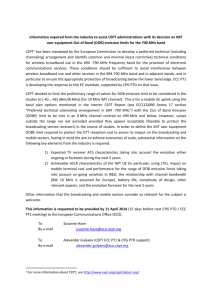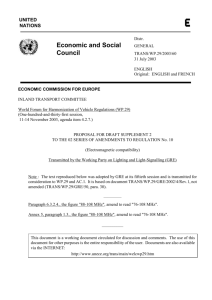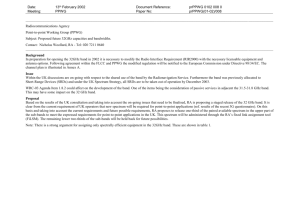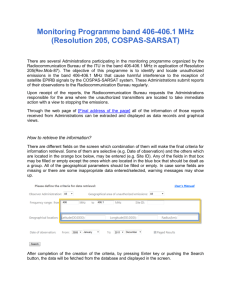EUROPEAN COMMUNICATIONS COMMITTEE
advertisement
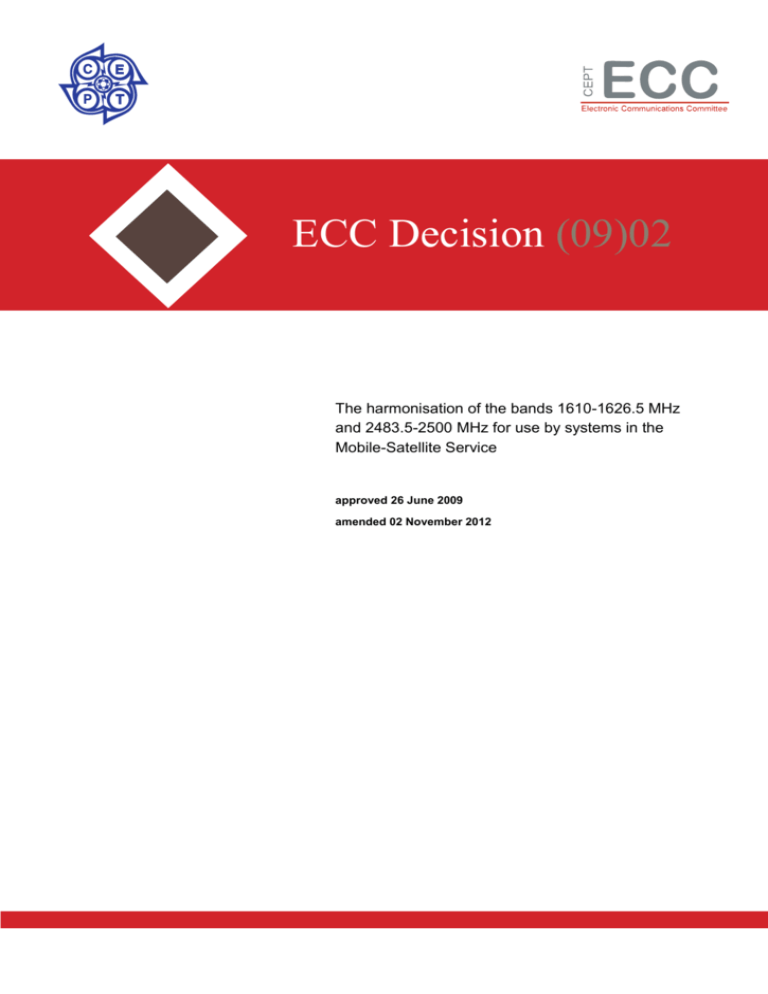
ECC Decision (09)02 The harmonisation of the bands 1610-1626.5 MHz and 2483.5-2500 MHz for use by systems in the Mobile-Satellite Service approved 26 June 2009 amended 02 November 2012 ECC/DEC/(09)02 EXPLANATORY MEMORANDUM 1 INTRODUCTION The ECC review of the regulatory framework of Decisions affecting the mobile-satellite service for the bands 1610-1626.5 MHz and 2483.5-2500 MHz has been undertaken to take account of changes since 1997, when satellite PCS systems were in development. The aim of this Decision is to: reflect the provisions already made by CEPT for a common approach to the mobile satellite service (MSS) allocations and to harmonise the use of spectrum within the bands 1610- 1626.5 MHz and 2483.5-2500 MHz for Mobile Earth Stations (MES’s); allow the withdrawal of ERC/DEC/(97)031. 2 BACKGROUND WARC-92 allocated spectrum to mobile-satellite service on a worldwide basis in the bands 1610-1626.5 MHz (Earth-to-space), 1613.8-1626.5 MHz (space-to-Earth) and 2483.5-2500 MHz (space-to-Earth). Within CEPT, a regulatory scheme applicable for Satellite Personal Communications Services (S-PCS) was established in 1997. The relevant Decisions, which provided the basis for authorising S-PCS systems throughout Europe, were: - ERC/DEC/(97)03 relating to the Harmonised Use of Spectrum for Satellite Personal Communications Services (S-PCS) operating within the bands 1610-1626.5 MHz, 2483.5-2500 MHz, 1980-2010 MHz and 2170-2200 MHz; - ERC/DEC/(97)05 on Free Circulation, Use and Licensing of Mobile Earth Stations of Satellite Personal Communications Services (S-PCS) operating within the bands 1610-1626.5 MHz, 2483.52500 MHz, 1980-2010 MHz and 2170-2200 MHz within the CEPT; and - ECTRA/DEC(97)02 on Harmonisation of Authorisation Conditions and Co-ordination of Procedures in the field of Satellite Personal Communications Services (S-PCS) in Europe, operating within the bands 1610-1626.5 MHz, 2483.5-2500 MHz, 1980-2010 MHz and 2170-2200 MHz. The regulatory scheme established under these Decisions related to systems that were planned to be brought into operation by 31 December 2000. Two such systems were brought into operation by that date and continue to provide commercial service in CEPT countries. Several other systems were identified at the beginning of this process but have not been developed to an operational status in the CEPT. The two MSS networks, Globalstar and Iridium, currently providing service within the bands 1610-1626.5 MHz and 2483.5-2500 MHz in the CEPT are registered in the United States and subject to the licensing regime of the Federal Communications Commission (FCC). Whilst CEPT administrations are not obliged to follow the terms of any licences granted by the FCC, these MSS operators will need to consider any impact of their licence conditions when operating outside the US. 1 ERC/DEC/(97)03 has been withdrawn on 26 June 2011 ECC/DEC/(09)02 3 REQUIREMENT FOR AN ECC DECISION The ECC recognised that a harmonised framework for the implementation of mobile-satellite service in the bands 1610-1626.5 MHz and 2483.5-2500 MHz was beneficial to satellite operators and manufacturers, and benefited the public with the availability of innovative new services. The ECC believes that the trans-national nature of satellite services necessitates the harmonised use of the considered frequency bands across the CEPT, and a commitment by CEPT member countries to implement this Decision will provide a clear framework to National Regulatory Authorities and operators to continue and enhance the applications available through these satellite services. This ECC Decision provides the necessary provisions for the harmonisation of the bands 1610-1626.5 MHz and 2483.5-2500 MHz for use by systems in the mobile-satellite service. 4 ADOPTION OF THE DECISION Administrations that reference ERC/DEC/(97)03 within their national legislation should note that this Decision has been withdrawn on 26 June 2012. ECC/DEC/(09)02 ECC Decision of 26 June 2009 (amended 02 November 2012) on the harmonisation of the bands 1610-1626.5 MHz and 2483.5-2500 MHz for use by systems in the Mobile-Satellite Service (ECC/DEC/(09)02) “The European Conference of Postal and Telecommunications Administrations, considering a) that WARC-92 allocated the bands 1610-1626.5 MHz (Earth to space), 2483.5-2500 MHz (space to Earth), to the mobile-satellite service (MSS) on a primary basis, and the band 1613.8-1626.5 MHz (space to Earth) on a secondary basis; b) that the use of the frequencies mentioned in considering (a) above is subject to co-ordination under Radio Regulations No. 9.11A; c) that the transmissions from mobile satellite user terminals in the band 1610-1626.5 MHz are subject to the e.i.r.p. limits given in Radio Regulations No. 5.364; d) that Radio Regulations No. 5.372 requires that harmful interference shall not be caused to stations of the radio astronomy service using the band 1610.6-1613.8 MHz by stations of the mobile-satellite service in the bands 1610-1626.5 MHz; e) that ERC Report 25 indicates the major utilisation expected in the bands 1610-1626.5 MHz and 2483.52500 MHz is for mobile satellite applications in the mobile-satellite service; f) that ERC Report 26 addresses the compatibility between mobile satellite user terminals operating in the band 1610-1626.5 MHz and the radio astronomy service in the band 1610.6-1613.8 MHz; g) that currently two satellite systems providing voice and data communication have been brought into operation in the bands mentioned in considering (a) above; h) that ECC Report 45 on “Sharing and adjacent band compatibility between UMTS/IMT-2000 in the band 2500-2690 MHz and other services” provides the result of compatibility studies between MSS and terrestrial IMT around 2500 MHz; i) that the free circulation and licence exemption of the mobile satellite user terminals is subject to separate ECC Decisions; j) that harmonised frequency assignment for mobile satellite user terminals in satellite systems in Europe has facilitated the efficient use of spectrum; k) that ECC Report 95 has concluded that for the most likely operational scenarios, the more appropriate way to achieve compatibility is for frequency separation of satellites systems using CDMA and TDMA technologies; l) that ECC Report 112 assessed the impact of interference generated in August 2006 by one NGSO system currently operating in the band 1618.25-1626.5 MHz (secondary space-to-Earth), on the Radio Astronomy service in the band 1610.6-1613.8 MHz and found data loss to be within the limits in Recommendation ITU-R RA.1513 but that the assumptions made in ECC Report 112 have been reviewed, and a further and more sophisticated measurement campaign was conducted in June 2010 resulting in ECC Report 171; ECC/DEC/(09)02 m) that ECC Report 171 assessed the impact of interference generated by unwanted emissions of one NGSO system currently operating in the band 1618.25-1626.5 MHz (secondary; space-to-Earth) on the Radio Astronomy service in the band 1610.6-1613.8 MHz (primary). The percentage of assessed RAS data loss produced in one single 20 kHz channel ranges between 90-100% for 2000 seconds integration times and between 5 and 44% for 30 seconds integration times during daytime operations of that NGSO system and exceeds the 2% criterion contained in Recommendation ITU-R RA.1513 by a wide margin; n) that the loss of data in considering m) results in severe restrictions on the Radio Astronomy service in the band 1610.6-1613.8 MHz; o) that for existing satellite systems, expected to be replaced by 2016, currently operating downlinks in 1613.8–1626.6 MHz, there are limited operational measures that can be implemented to improve compatibility with the Radio Astronomy service without severe restriction to these systems, and that all conceivable measures to reduce interference are under consideration and being investigated; p) that spectrum sharing arrangements for use of the band 1610-1626.5 MHz and 2483.5-2500 MHz should preferably be developed between the MSS operators; q) that frequency band 1610-1620 MHz is used for GNSS receivers brought into operation before 2006, appropriate measures should be taken by MSS operator in accordance with ITU-R Recommendation M.1343-1 to avoid interference into such receivers from MSS terminals operating in the band 1610- 1626.5 MHz; r) that some administrations have authorised mobile satellite user terminals and/or MSS systems in a specific segmentation of the band between CDMA and TDMA operation in accordance with earlier ERC Decisions and that any changes to existing national licences and regulations as a result of this new Decision may take some time to implement; s) that in EU/EFTA countries the radio equipment that is under the scope of this Decision shall comply with the R&TTE Directive. Conformity with the essential requirements of the R&TTE Directive may be demonstrated by compliance with the applicable harmonised European standard(s) or by using the other conformity assessment procedures set out in the R&TTE Directive. DECIDES 1. that the frequency bands 1610-1626.5 MHz (Earth-to-space), 1613.8-1626.5 MHz (space-to-Earth) and 2483.5-2500 MHz (space-to-Earth) are harmonised for use by systems of the mobile-satellite service; 2. that, prior to 1 January 2016, administrations shall consider the interference situation of the Radio Astronomy service operating below 1613.8 MHz before considering granting an authorisation for operation of mobile earth stations operating under the control of MSS systems using downlinks in the frequency band 1613.8-1626.5 MHz (space-to-Earth); 3. that CEPT administrations urge the involved parties (MSS operator and radio-astronomers) to investigate and implement appropriate technical and/or operational short term solutions to alleviate the interference situation; 4. that, after 1 January 2016, in order to protect the Radio Astronomy service in the frequency band 1610.61613.8 MHz, administrations shall only authorise operation of mobile earth stations under the control of MSS systems provided the following conditions are met: 2 that in accordance with Recommendations ITU-R RA.769-2 and ITU-R RA.1513 the spfd-level at radio astronomy stations is limited to -238 dB(W/m²Hz)2,3 and the data loss resulting from exceeding this limit is ≤ 2% in one or more 20 kHz channels within the frequency band 1610.6-1613.8 MHz at the location of the radio astronomy station from the corresponding MSS system using downlinks in the frequency band 1613.8-1626.5 MHz (space-to-Earth); This value is based on an integration time of 2000 seconds. The interference levels given are those which apply for measurements of the total power received by a single antenna. Less stringent levels may be appropriate for other types of measurements (see Recommendation RA.769-2). However, all European observatories are carrying out single dish observations at the time of adoption of this ECC Decision. 3 ECC/DEC/(09)02 that the operation of mobile earth stations transmitting in the band 1610-1626.5 MHz is not allowed within a radius calculated on the basis of Figure 1 in the Annex around each radio astronomy station operating in the frequency band 1610.6-1613.8 MHz while taking due account of the shielding effects of the terrain at the relevant radio astronomy site; 5. that the compliance with the conditions for use of radio frequencies by current and future MSS systems in the band 1613.8-1626.5 MHz (space-to-Earth) and the degree of interference in the frequency band 1610.61613.8 MHz caused by this usage shall be monitored regularly (e.g. once a year) by a competent body and the results be reported to the ECC; 6. that this Decision shall enter into force on 02 November 2012; 7. that the preferred date for implementation of this Decision shall be 01 May 2013; 8. that CEPT Member administrations shall communicate the national measures implementing this Decision to the ECC Chairman and the Office when the Decision is nationally implemented.” Note: Please check the Office documentation database http://www.ecodocdb.dk for the up to date position on the implementation of this and other ECC Decisions. ECC/DEC/(09)02 Annex (Extract from ERC Report 26) In this Annex, a mobile terminal channel is assumed to operate next to a radio astronomy observation (1610.61613.8 MHz). The aim of the following calculations is to evaluate the maximum out-of-band emissions from the operating MES to prevent interferences to the radio astronomy service. For this calculation, the MES is assumed to be not closer than 1 km from the radio astronomy observatory (this assumption is based on the size of a radio astronomy site). Using a free space propagation model, the maximum acceptable out-of-band emissions from the MES in any radio astronomy channel is then -129 dB(W/4kHz), i.e. -10 dB(pW/3kHz). If out-of-band emissions in the band 1610.6-1613.8 MHz are higher than this value, the MES should not emit in a given area around the radio astronomy observatory. For the out-of-band level to be low enough, the required separation distance can be computed using the Okumura-Hata propagation model valid for a distance smaller than 100 km. The relation between out-of-band emission level and the separation distance is given in the Figure below. 80 70 60 50 Out of band 40 emission level (dB(pW/3kHz)) 30 20 10 0 -10 0 10 20 30 40 50 60 70 Separation distance (km) (assuming OKUMURA propagation model) 80 90 100


